Slappa CD cases rock! I use them for my CDs, and now finding the perfect next tune in my CD collection is 100 times easier. Check them out!
Now with 5% off if you use the link above or enter "Recess" in the discount area!
The Technical Stuff
Connections and Amps etc
Technical informations
See chapter 11 in the book for in depth detail
Here's another legacy page from the old site which I should really change in order that I don't give away all the information contained in the book! It deals with what rating of amplifier you'll need, and the correct way to hook up your speakers.
In case you have a burning desire to know how records are made, what the RIAA curve is and other groovy things (bad pun) then go to this site (click on the image above) which is a company in the States which presses tunes. As well as the normal company info, there's some really interesting Tech reading on there too.
Here's the headings of this page, in case you want to jump:-
CONNECTORS
I'll take you through a few of these connectors first.
The most common ones that you'll come across as a Dj are XLR's, Phono's (also known as RCA connectors) and 1/4 Inch Jacks.
XLR connectors are the professional choice when it comes to microphones. There's two reasons for this. 1) They aren't easily pulled out of their sockets (unlike 1/4 Inch Jacks) and they come in two forms - Balanced and Unbalanced. The most common one you'll come across is the Unbalanced one as most Dj mixers wont accept Balanced ones. The difference (if you care) is this:-
Unbalanced connector wires have one or two conductors (normally stranded) and a shield. Those with two conductors are often arranged as a twisted pair. The connector is a single lead 'RCA' or 'phono' connector with a ground ring.
Balanced connectors have three conductors: two for the signal, one for ground, and additionally a shield. The standard connector for balanced cable is the locking three prong XLR connector. If you have to run cables longer than 12 feet or 4 meters, balanced connectors provide greater noise immunity. They are standard equipment in professional installations such as production studios and broadcast facilities. Balanced connectors are able to provide greater noise immunity due to phase cancellation on the common ground lead.
This is a (badly drawn) picture of a face on view of the male XLR connector - you can see why some people call it a "three pin-din".

I'll mention the 1/4 Inch Jack next, because it ties in with the XLR as a mic connector. Basically, it's the one that's at the end of your headphones (unless you're using ones with 1/8 Inch Jacks) A lot of Dj mixers now have a Neutrik Combo XLR input, which means it can take the XLR (above) and the 1/4 inch jack too - that's why there's a big hole in the middle of the mic input - and why it looks 'funny'.
 The 1/4 Inch Jack - Notice the two black bands on the end, this means it's stereo. Only one means it's mono.
The 1/4 Inch Jack - Notice the two black bands on the end, this means it's stereo. Only one means it's mono. 
(Kind of) the Neutrik Combo connection - I should have paid attention during art classes!
Next after that appalling show of art work is the Phono/RCA connector. These are the most common connection as inputs and outputs into Dj mixer units. Normally, they come in two's, left and right. If you don't know what one is what, shame on you!! The RED one is RIGHT and the WHITE (or sometimes YELLOW) one is LEFT. The right side jack is (nearly) always RED in colour, so you just have to remember that R is R (Red and Right)

A phono/rca jack though this is silver, there are normally indicators 'somewhere' of whether it's + or - (can you remember color is what? Correct. You win a cookie!)
The last thing to mention here is the third wire that comes out the back of your turntables. This is the GROUND connection. Go on, you know you want to connect it...... Look for a thumb screw on the back of your mixer marked GROUND or it maybe marked like this:-
------------
--------
----
Place the metal bits at the end of the ground wire so that when you tighten this screw, the wires between the two metal parts 'inside' the screw. You've now grounded your decks! I'd give you a cookie, but everyone is getting the last question right, and I've run out.
IMPEDANCE
Ok, the next part I'm going to mention is IMPEDANCE.
This is crucial in the sound of your stuff. It's very possible (and likely) that if there is a mismatch in impedance (measured in OHMS), there sill be a significant reduction in sound quality. Here's a reference:-
High Impedance output into a low impedance input
- Distortion caused by the higher voltage,
Low impedance output into a high impedance input
- Too little signal,
- Muffled tone and accentuated bass.
Thus, we need to match the impedance of generator (source) to the load (destination). Often, a small mismatch will be passable, but the input impedance should be lower than that of the following circuit - i.e. Low into High will go, but high into low will not - damage!!
Particularly in the case of loudspeakers, an impedance mis-match won't do too much harm. But when feeding the output of a 100w amp into a loudspeaker you need to know the max power of the amp and at what impedance figure it's quoted at. Make sure your speakers can take the worst case - or you can blow your speakers (believe me, been there, done that!) This also applies to headphones, check the impedance quote on your mixer and try to get phones that match. Also, at the other end of the scale, you'll want to know that the amp is powerful enough to drive the speaker to a reasonable output.
So, let's assume that you're just using a normal Hi-fi to pump out your tunes (like I do at home). My stereo is rated at 5 Ohms. The speakers I got were pretty crappy, so I decided to use ones I had lying around in the loft. These are 8 Ohms. Not much problems here, but I wasn't happy with the amount of coverage these speakers had in the size of room I play in. So I decided to pick up a couple more speakers . I ended up getting six more, 2 @6 Ohms and 4 @ 4 Ohms. I know, overkill, but I wanted one speaker in each corner, and two on the floor - which are remarkable for bass with two small speakers for the high frequencies with them.
So I've now got a 8 ohm speaker, a 6 Ohm speaker and two 4 Ohm speakers.
If I just wired them all straight into the back of the stereo - in "PARALLEL" then the total impedance would be 1.26 Ohms (I'll tell you why in a second)
If I wired them in all in "SERIES", then the total would be 22 Ohms.
How do I come to these figures you ask? Physics at school. The only thing I properly paid attention to. You'll probably have worked out that to get the figure for connections in series , you only have to add up the individual ratings to get the total. Parallel is a bit more complicated. I'll take you through this process below.
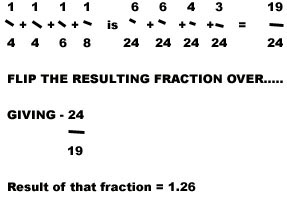
Please excuse the messyness of me trying to put in fractions, but I had to do that in Photoshop, otherwise it'd be all like 1/4 + 1/4 +1/6 +1/8 which isn't very friendly.
Basically, you turn the figure into a fraction and flip it - so that 8 (which is 8/1) now becomes 1/8 etc. Then add them together. You have to find a common denominator if they aren't the same impedance - in this case 24 because 8, 6 and 4 all go into 24 properly. Once added (remembering to only add the top figure) flip the result over - so that 19/24 is now 24/19. Nineteen goes into twenty four 1.26 times, so you're left with 1.26 Ohms as the result .
That took a while!! So what I ended up having to do was connect some of them in series, and some of them in parallel. This is when it really DOES get confusing!!!!
The two FOUR ohm speakers were connected together in SERIES.
The EIGHT and the SIX were connected in SERIES, and the resulting two sets were connected in PARALLEL.
So, finally my resulting speaker impedance becomes 5.1 Ohms - close enough!!!! Here's the math:-
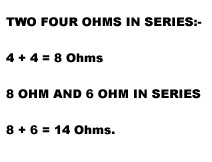
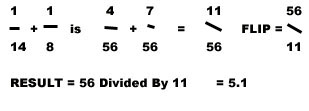
So, I know the next question on your lips. "How do I connect them in Parallel or in Series?"
You had to ask!!
Parallel is easy, just get the two wires (+and -) , connect all the + ones from each speaker together, and all the - ones together. Now stick 'em into the back of your stereo.
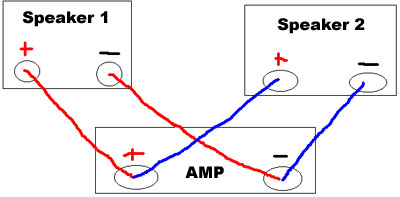
Sorted. All connected in parallel.
Connecting in series is a bit more difficult:-
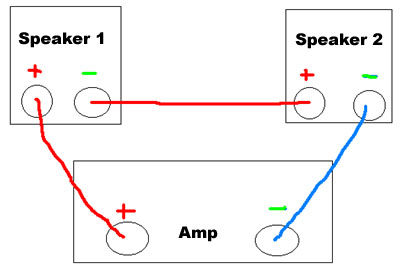
Got it? The difference is that the + wire of the first speaker goes into the + of the amp, the - of the speaker goes to the + of the second speaker, and the - of the second speaker goes into the amp. The disadvantage of using a series configuration is if one of the speakers burns up, the other one(s) stop producing sound.
So the end result (and remember this is only the one side, I still had to do the same for the other) looks like this:-
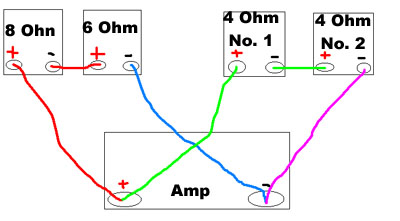
It seems like a lot of work (and maths) just to get your speakers in-line but it's worth it in the end - if only for the superior sound quality.
AMPS
Firstly, can I say that all the stuff I've got here has been gained through two methods. 1) research on the net - 2) Dave, the Technician at the College I used to go to. I don't know anything apart from what's here about this stuff. So please, no more mails asking me what amp power to use when plating in a carpeted toilet etc, I just DON'T KNOW!! :-p
I'm going to try as best as I can to steer away from using any brand named Amps and stuff. Everyone has their own opinion as to what is better, and I can't be bothered starting an argument today. Maybe tomorrow......
I'll go into a nice "history" of what you need first, for those of you who don't know much about amps and stuff.
The first thing to talk about is power ratings. Amplifiers and Speakers BOTH have power ratings. Generally speaking, the rating on the back of your amp will be to tell you the maximum sustained output that the amp can produce. On speakers, however, there are two ratings. The AVERAGE and the PEAK rating. The average rating (also known as RMS) refers to the maximum SUSTAINED output that your little bundles can handle. The peak rating refers to how much power they can handle momentarily. Put a little thought into it, and you'll find it's obvious that the PEAK is always higher than the AVERAGE, and is why manufacturers like to print the PEAK in there documentation - it makes the speaker look more powerful.
Again, common sense would prevail to give the reasoning that the AVERAGE rating of the speakers should be higher than the power rating of the amplifier - there should be no chance of the amp blowing a speaker this way. No matter what though, the PEAK power rating MUST be higher than the output of the amp.
So, how do you pick amps and stuff then. Well, there's even more physics involved in this choice. If, say, you want to produce 200W of sound, you'd think it would be a safe bet to go out and buy a 200W amp, and speakers that will easily handle this power - but what if the amp breaks down, you could get two 100w amps (each amp with its own set of speakers) to make up the 200W so that there is a back up if the first one fails.
Yes, they are both options, but the 'preferred' way is this;
Buy three 100W amps (and sets of speakers), and run each of them at two-thirds of their power. This way, you don't really have to worry about your units collapsing due to the vigours of running at full whack the whole time. Plus, if one of the amps in the 2x100w option blows, you've lost half of your power - if one of your amps in the 3x100w option blows, you've only lost a third, and there's still the option of turning up the remaining two a little (all though, you have to think why the first one blew - it might still happen to the remaining two.)
One last physics point though. Although 2x100w amps will give around the same power as a single 200W amp, a 200W unit is not TWICE as powerful as the 100W amp - it's just more powerful. To double the amount of power you have to increase the power of the amp tenfold. (wasn't he in Dangermouse? Penfold you say? Ah, Ok.)
So, how much power do you need? Buggered if I know!! Kidding, I found a really good chart for this on a page somewhere, in fact it was that page that taught me all the stuff above, if I ever manage to find it, I'll contact them and make sure to link to them. I'll cut down their table though (actually, it's only what I can remember, it just seems like I haven't forgot it if I say I've edited it.....)
| Room Size | Amp power (in watts per channel) for pumping, ear bleeding dance music. |
| Empty(ish) Bedroom | 20-40 |
| Full(ish) Bedroom. | 40-60 |
| Big room, small hall - half full. | 80-150 |
| Large hall, half full. | 150-300 |
| Large hall, jumpin' with people. | 500-800 |
The other thing that you're now going to think about it the decor. This doesn't really apply if the room is packed with people, but you have to understand that a room with wooden floors and wooden walls is going to reflect the power through the room, so you don't need as much power. Inversely, a room that is covered in carpet, has big, thick curtains in it, is going to absorb a lot of the power, so you may need a touch more. The point about the people is that they act (amongst other things) like carpets and curtains, they absorb a lot of the power into their drink riddled bodies.
So, far I'm already bored by this page, it's too tekkie!! So I'm gonna stop here, until I can think of other relevant stuff that will bore the rest of you to tears! If anyone has found any bollocks in this page, please tell me! I don't want to make it look like I think I know stuff, and have ended up typing in complete nonsense!

